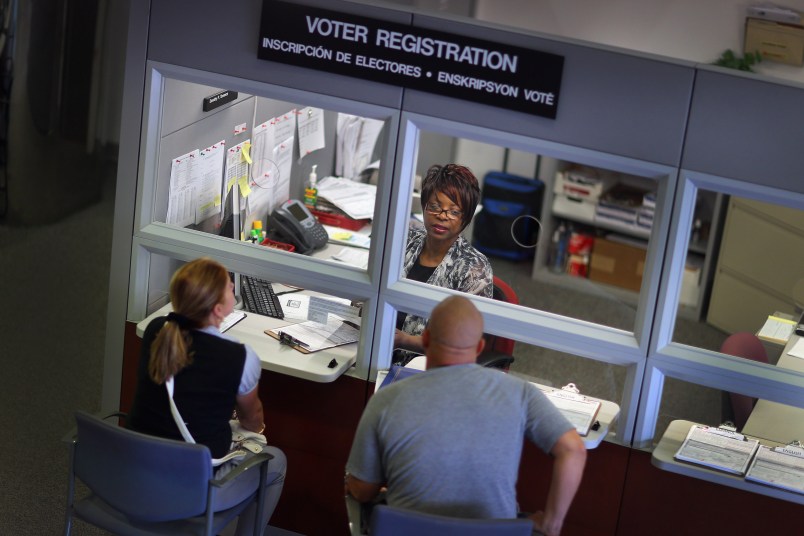As legislative efforts to expand voting rights hit the brick wall of the filibuster in the Senate, and as conservative courts across the country side with state Republicans’ novel restrictions on the franchise, the third branch of government is preparing to fill in the gaps where it can. And for members of Joe Biden’s Cabinet, homework is due.
A couple months after taking office, on the 56th anniversary of the “Bloody Sunday” march in Selma, Alabama, Biden ordered executive branch agencies to “consider ways to expand citizens’ opportunities to register to vote” and participate in the electoral process.
The President gave agencies 200 days to get plans in order and submit them to the White House. The deadline was Thursday.
In the intervening months, behind-the-scenes and in public recommendations, voting rights advocates have sought to influence the Biden administration to go big: The Department of Education could incorporate voter registration into the online applications for student aid, for example. Social Security officials across the country could prompt elderly and disabled Americans to register to vote at the agency’s hundreds of field offices.
From citizenship ceremonies to healthcare.gov, the federal government’s footprint provides endless options.
“People should be able to access voter registration opportunities whenever and wherever they interact with the government,” said Lisa Danetz, an advisor at the Brennan Center for Justice.
Would the effort rival the democratic reforms being considered by Congress, such as the Freedom to Vote Act? No, advocates involved in the process agreed. But if done right, it could have a significant impact.
“These agencies are reaching many, many millions of Americans every day,” said Danielle Lang, director of voting rights at the Campaign Legal Center.
That’s particularly true of large federal agencies that deal directly with would-be voters, like the Social Security Administration, the Department of Education and the Indian Health Service.
Where the government is already interacting with citizens, there’s an opportunity to add voter registration opportunities and education on crucial information like deadlines and ID requirements.
Non-profits do an “enormous” amount of work on this front, Lang said, but it’s expensive and labor-intensive.
“Agencies have such a head start, because they already are in touch with so many millions of people, and already have these institutions that they can work through,” she said. “They can do that kind of work much more efficiently.”
Laura Williamson, a senior policy analyst at Demos who’s been on calls with the administration about the executive order, said her organization has been encouraged by the commitment and creativity they’ve seen from the White House and “at least some” of the agencies.
But Williamson acknowledged that the order can only go so far. The Biden administration has come under criticism from some activists for the sentiment, sourced to unnamed White House officials, that it’s possible to “out-organize voter suppression.”
“Voter registration can only do so much if all the polling places in your community were closed, or moved out of transportation access, or if you need to vote by mail and you can’t because the vote-by-mail laws are so restrictive in your state now,” Williamson said.
On the other hand, the analyst argued that the order represents an opportunity “completely within the administration’s control.” She noted the difference between a stack of federal voter registration forms buried at the bottom of a clerk’s desk, and proactive outreach that’s accessible, and for which statistics are kept for the sake of accountability.
“There is a wide gulf between a strong voter registration plan and a weak voter registration plan,” Williamson said. At the state level, where Demos has long worked on voter registration efforts, “there are millions more voter registrations that come out of agencies that do it well,” she added.
For Danetz, the Brennan Center advisor, the executive order recalled years of trying to reach potential voters through the National Voter Registration Act, the 1993 law that set national standards to provide voter registration access at state DMV offices and other venues where citizens interact with government officials, like military recruitment centers.
That law contains language about federal agencies cooperating with states’ efforts, but gives the agencies the option not to get involved. The Biden order puts the onus on the feds to proactively pitch in, or else explain in writing why they aren’t.
“The history of implementation of the NVRA is agency resistance,” Danetz said. “So the idea that this is going to finally expand for the federal government is very exciting.”
“When I saw the executive order,” she said, “I got chills.”







I get the feeling that registration is only the 1st bottleneck to voting and the least likely to prove useful if unblocked.
Stop trying to attack an elephant with a BB gun already.
Well with what is going on in some states we have to work on all way to get potential voters registered, and then work on getting people to the polls. They go hand in hand.
We need S1.
I really can’t understand why registering to vote isn’t consistent from one state to the next.
OT: A fucking mass shooting. Why do I suspect it has something to-do with masks?